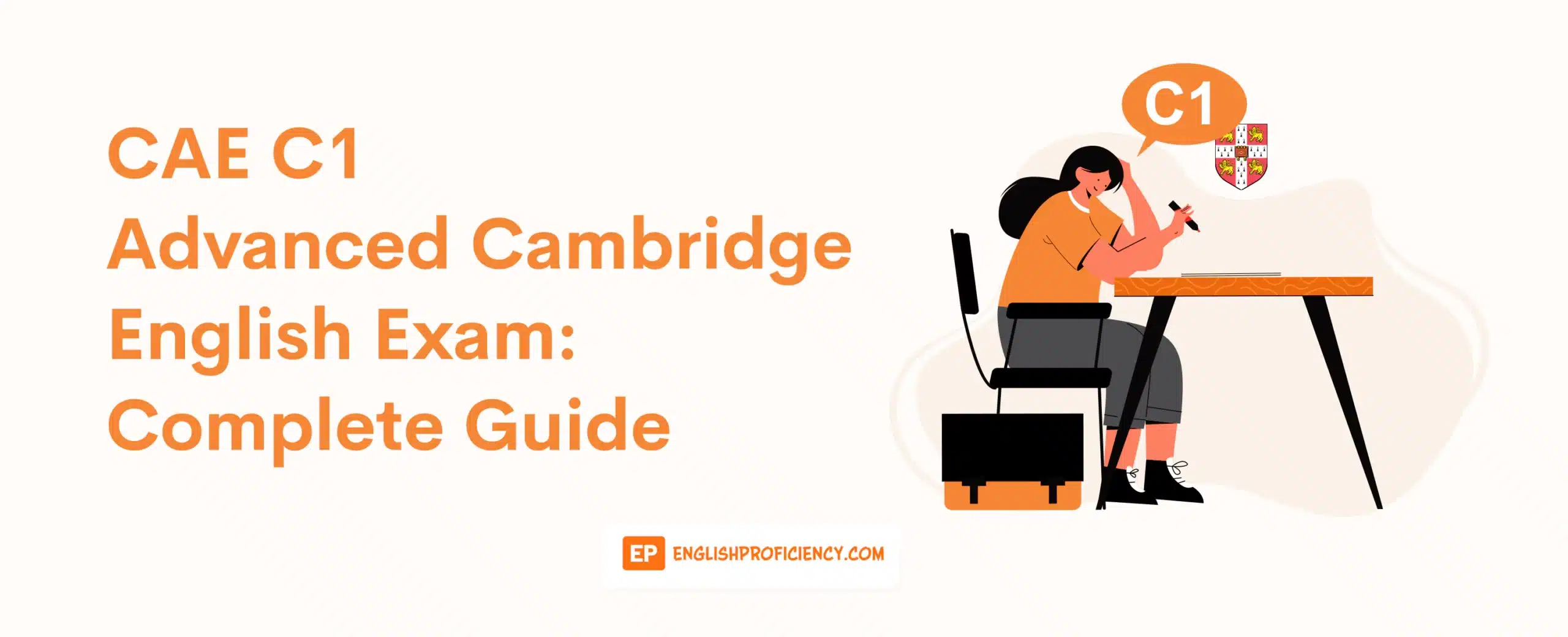The Cambridge English Exams are one of the world’s leading English language proficiency exams used by prestigious universities, colleges, government offices, and private sectors worldwide.
The test is taken by over 3.5 million test takers every year across 130 countries. The CAE C1 Advanced exam is one of the English language exams offered by Cambridge Assessment Group. To learn more about the CAE C1 Advanced Test, we have developed a comprehensive guide for the exam. Read on.
- What is the CAE C1 Test?
- Why Take the CAE C1 Test?
- How Much Does the CAE C1 Test Cost?
- Where is the CAE C1 Test Accepted?
- CAE C1 Advanced Test Exam Format and Structure
- How Does Scoring for the CAE C1 Exam Work?
- CAE C1 Advanced Exam Dates and Locations
- When are the CAE C1 Certificates Available After the Exam?
- How to Prepare for the CAE C1 Test?
- Additional FAQs on the CAE C1 Advanced English Exam
What is the CAE C1 Test?
The C1 Advanced Test is commonly known as the Cambridge English: Advanced (CAE). It is also formerly known as the Certificate in Advanced English (CAE) and one of the Cambridge English language exams suite.
The CAE C1 Advanced Cambridge English Exam is an English assessment tool typically used to measure individual English language skills. It is also used to assess the C1 level language proficiency of a candidate.
Moreover, the CAE C1 test is required by most educational institutions such as international universities and colleges worldwide for their admission requirements. The CAE C1 Test is also recognized by some of the distinguished companies around the world.
CAE C1 Advanced Test is distinct from the C2 Proficiency English Test (CPE), even though they are both administrated by the Cambridge Cambridge Assessment Group. The group also partners with the British Council, IDP, IELTS Australia to co-create, manage and administer the IELTS Exam.
Why Take the CAE C1 Test?
The CAE (Certificate in Advanced English) C1 Advanced Test is one of the most highly accepted and sought-after English proficiency tests worldwide. It is also accepted by over 9,000 institutions, governments agencies, and well-known private organizations around the globe.
Most organizations prefer the CAE C1 because of its in-depth and high-level qualification in assessing your English language proficiency. In addition, the certification from the CAE C1 is legit and excellent proof of your high-level achievement in the English language.
If you achieved a CAE C1 certification, you could effectively communicate at a managerial and professional level. And the CAE C1 certification shows that you are eligible and can follow an academic course at a university-level where the English language is the medium of instruction.
It is also one of the doors for you to work and study abroad. Moreover, your CAE C1 certification is proof of your skills in the English language, wherein you can confidently participate in workplace meetings, academic discussions, and other related activities that use the English language.
How Much Does the CAE C1 Test Cost?
The price of the CAE C1 Advanced Test varies depending on the different test centers worldwide.
However, it is approximately around USD 165 to USD 195. Or it is somewhere between EUR 150 to EUR 170.
And in India, the latest fee for the CAE C1 Advanced Test is around RS 6,000. In Poland, the language proficiency test costs around PLN 1,800.
Where is the CAE C1 Test Accepted?
The CAE C1 Advanced Test is accepted by over 9,000 educational institutions and private organizations worldwide. And it is also recognized by the most prestigious employers around the world, such as Coca-Cola, Siemens, KPMG, Adidas, and more.
There are over 2,800 testing centers available in over 130 countries around the world.
In addition, the CAE C1 test also has over 50,000 preparation centers located in various countries globally to help you review it.
Which Countries Accept the CAE C1 Test?
- Australia
- Canada
- France
- Germany
- Hong Kong
- Italy
- Japan
- Spain
- Switzerland
- UK
- USA
Which Universities and Colleges in Australia Accept the CAE C1 Advanced Test?
- University of Adelaide
- University of Canberra
- University of Melbourne
- University of New England – Australia
- University of New South Wales
- University of Newcastle
- University of Notre Dame – Australia
- University of South Australia
- University of Sydney
- University of Tasmania
- University of Technology Sydney (UTS)
- University of Sunshine Coast
- University of Western Australia
- University of Western Sydney
- University of Wollongong
- Victoria University
- William Angliss Institute of TAFE
- Australia Institute of Business and Technology
- Australian Institute of Music
- Australian Maritime College
- Australian National University (ANU)
- Bond University
- Bradford College – Adelaide
- Canberra Institute of Technology (CIT)
- Carnegie Mellon University, Australia
- Central Queensland University
- Charles Darwin University (CDU)
- Charles Sturt University
- Chisholm Institute of TAFE
- Curtin College
- Deakin University
- Edith Cowan University
- Elite Education Institut Pty Ltd
- Endeavor College of Natural Health
- Federation University
- Flinders University
- Gold Coast Institute of TAFE (GCIT)
- Griffith University
- Harward International College
- Holmesglen Institute of TAFE
- International College of Hotel Management (ICHM)
- International College of Management Sydney (ICMS)
- James Cook University
- JMC Academy
- Kangan Batman Institute of TAFE
- Kaplan Business School
- Kent Institute of Australia
- King’s Own Institute (KOI)
- La Trobe University
- Macquarie University
- Melbourne Institute of Business and Technology (MIBT)
- Melbourne Institute of Technology
- Monash University
- Murdoch University
- Nan Tien Institute
- Pacific College of Technology
- PAX Institute of Education Pty Ltd
- Perth Institute of Hospitality and Tourism
- Queensland University of Technology
- Torrens University
Which Universities and Colleges in the USA Accept the CAE C1 Advanced Test?
- University of Akron
- University of Arizona
- University of Arkansas
- University of Central Florida
- University of Chicago
- University of Cincinnati
- University of Colorado Denver – CU Anschutz Medical Campus
- University of Dayton
- University of Delaware
- University of Denver
- University of Florida
- University Hartford
- University of Hawaii
- University of Houston – Victoria
- University of Idaho
- University of Illinois
- University of Indianapolis – United States
- University of Kansas
- University of La Verne
- University of Maine
- University of Michigan
- University of Minnesota
- University of Mississippi
- University of Missouri
- University of Montana
- University of North Carolina
- University of Rhode Island
- Walsh University
- Washington Unversity in St. Louis
- Wellesly College
- Albany State University
- Argosy University
- Arkansas State University
- Art Institute of Atlanta
- Belmont University
- Benedictine College
- Berkeley College
- Boise State University
- Boston Architectural College
- Bunker Hill Community College
- California College of the Arts
- Central State University
- City University of Seattle
- Cleveland State University
- Columbus State University
- Concordia College
- Dartmouth College
- De Anza College
- Florida Institute of Technology
- Fordham University
- Franklin University
- Georgia State University
- Harvard College – Harvard University
- Harvard Kennedy School
- Humboldt State University
- Johns Hopkins University
- Lincoln University – California
- Longwood University
- Louisiana State University
- Manchester University
- Marquette University
- Metropolitan State University
- Michigan State University
- Monmouth University
- National University
- New Brunswick Community College
- North Park University
- Ohio Northern University
- Old Dominion University
- Oregon State University
Which Universities and Colleges in the United Kingdom Accept the CAE C1 Advanced Test?
- University College Birmingham
- University College London (UCL)
- University of Aberdeen
- University of Bedfordshire
- University of Birmingham
- University of Bradford
- University of Brighton
- University of Bristol
- University of Buckingham
- University of Cambridge
- University of Central Lancashire
- University of Chester
- University of Derby
- University of Dundee
- University of East Anglia
- University of East London
- University of Edinburgh
- University of Essex
- University of Exeter
- University of Glasgow
- Unviersity of Greenwich
- University of Hertfordshire
- University of Huddersfield
- University of Leicester
- University of Lincoln
- University of Liverpool
- Unviersity of Manchester
- University of Northampton
- University of Nottingham
- University of Oxford
- University of Plymouth
- University of Portsmouth
- University of Salford
- University of Sheffield
- University of South Wales
- University of the Arts London
- University of West Scotland
- University of West London
- University of Westminster
- University of Worcester
- Webster Graduate School of London
- Welsh College of Horticulture
- Welsh School of Architecture
- West London College
- Winchester School of Art
- Anglia Ruskin University
- Architectural Association School of Architecture
- Aston Business School
- Bangor University
- Bedford College
- BIMM Institute – London
- Bournemouth University
- Bradford College
- Bridgwater College
- Brunel University
- Canterbury College
- Capel Manor College
- Cardiff University
- Central School of Speech and Drama
- City & Guilds of London Art School
- European Business School London
- Falmouth University
- Guildhall School of Music and Drama
- Harper Adams University College
- Henley Business School
- Imperial College London
- Keele University
- Kingston University
- Lancaster University
- London Business School
Which Universities and Colleges in Italy Accept the CAE C1 Advanced Test?
- Academy of Fashion – Naples
- Ca’ Foscari University of Venice
- Catholic University of the Sacred Heart
- Centro Linguistico dell’ Universita di Pavia
- CLMA – Universita degli Studi di Catania
- EIUC – European Inter University Centre for Human Rights and Democratisation
- Istituto Marongoni Milano
- John Cabot University
- KIC InnoEnergy Master School
- LUMSA University – Rome
- MIP Politecnico di Milano
- Monash University – Prato Centre
- Politecnico di Bari – Ufficio Placement
- Politecnico di Milano
- Polytechnic of Turin
- Seconda Universita di Napoli – Rettorato
- UME Graduate School, Institute for Advanced Study of Pavia (IUSS)
- UnivBocconiMI – Milan
- Universita Cattolica del Sacro Cuore – Bresica
- Universita degli Studi di Ancona
- Universita degli Studi di Bari Aldo Moro
- Universita degli studi di Bergamo
- Universita degli Studi di Cassino di Frosinone
- Universita degli Studi di Catania
- Universita degli Studi di Ferrara
- Universita degli Studi di Firenze
- Universita degli Studi di Foggia
- Universita degli Studi di Genova
- Universita degli Studi di Messina
- Universita degli Studi di Napoli Federico II
Which Universities and Colleges in Argentina Accept the CAE C1 Advanced Test?
- Universidad Abierta Interamericana
- Universidad Adventista del Plata
- Universidad Argentina de la Empresa (UADe)
- Universidad Austral
- Universidad Blas Pascal
- Universidad Catolica de Cordoba
- Universidad Catolica de Cuyo
- Universidad Catolica de la Plata – Argentina
- Universidad Catolica de Salta (UCASAL)
- Universidad Catolica de Santa Fe
- Universidad Champagnat – Argentina
- Universidad de Belgrano
- Universidad de Buenos Aires – School of Law
- Universidad de Congreso
- Universidad de Flores
- Universidad de Mendoza – Sede Rio Cuarto
- Universidad de Palermo
- Universidad de San Andres
- Universidad del Aconcagua
- Universidad del Cine
- Universidad del Salvador
- Universidad FASTA
- Universidad Nacional de Cuyo
- Universidad Nacional de Entre Rios
- Universidad Nacional de Mar del Plata
- Universidad Nacional de Misiones
- Universidad Nacional del Litoral (UNL)
- Centro Regional Universitario Cordoba IUA
- IIPE UNESCO Buenos Aires – Erasmus Mundus
- Instituto Nacional Superior del Profesorado Tecnico de la Universidad Tecnologica Nacional (INSPT)
- Instituto Superior del Profesorado Santa Trinidad
- Instituto Universitario CEMIC
- IUCBC Instituto Univesitario de Ciencias Biomedicas de Cordoba
- Pontificia Universidad Catolica Argentina (UCA)
Which Universities and Colleges in Belgium Accept the CAE C1 Advanced Test?
- Arteveldehogeschool
- Brussels School of International Studies
- College of Europe – Belgium
- EUREC
- Ghent University
- Hogeschool Wetenschap & Kunst
- Howest University College of West Flanders
- KU Leuven
- LUCA School of Arts
- Odisee
- Solvay Brussels School of Economics and Management
- Thomas More – University of Applied Sciences
- United Business Institutes – UBI Belgium
- Universite de Liege
- Universite Libre de Bruxelles (ULB) – Erasmus Mundus
- Universiteit Gent – Erasmas Mundus
- University of Antwerp
- The University of Kent – Brussels School of International Studies
- Vesalius College – Vrije Universiteit Libre de Bruxelles
- Vlerick Business School
- Vrije Universiteit Brussel
Which Universities and Colleges in Brazil Accept the CAE C1 Advanced Test?
- Centro Universitario Metodista
- Centro Universitario Newton Paiva
- Faculdade Cultura Inglesa
- FGV – Fundacao Getulio Vargas
- Fundacao Armando Alvares Penteado (FAAP)
- Fundacao Dom Cabral (FDC)
- INSED – Instituto de Educacao
- INSPER
- Pontificia Universidade Catolica do Rio de Janeiro (PUC – RIO)
- Rede de Ensino Superior PUC Sao Paulo
- Santa Casa de Belo Horizonte
- Universidade Castelo Branco (UCB)
- Universidade Catolica de Brasilia (UCB)
- Universidade de Passo Fundo (UPF)
- Universidade de Sao Paulo, Instituto de Medisina Tropical
- Universidade do Estado do Rio de Janeiro (UERJ)
- Universidade Estadual da Paraiba
- Universidade Estadual de Londrina (UEL)
- Universidade Federal de Alfenas
- Universidade Federal de Juiz de Fora
- Universidade Federal de Santa Catarina
- Universidade Federal de Sergipe
- Universidade Federal do ABC (UFABC)
- University of Brasilia (UnB)
- USP – Escola de Artes, Ciencias e Humanidades
Which Universities and Colleges in Canada Accept the CAE C1 Advanced Test?
- University Canada West
- University of Alberta
- University of British Columbia (UBC)
- University of Guelph
- University of King’s College
- University of Lethbridge
- University of Ottawa
- University of Prince Edward Island
- University of Regina
- University of Saskatchewan
- University of the Fraser Valley
- University of Toronto
- University of Victoria
- University of Waterloo
- Vancouver Film School
- Vancouver Island University
- Western University – Ontario
- Wilfrid Laurier University
- York University
- Yorkville University
- Acadia University
- Algoma University College
- Atlantic School of Theology
- Aurora College
- BETA College of Business and Technology
- Brandon University
- Brescia University College
- British Columbia Institute of Technology
- Burman University
- Canadian Mennonite University
- Canadore College of Applied Arts and Technology
- Coast Mountain College
- Columbia University – Canada
- Concordia University
- Crandall University
- Dalhousie University
- Emily Carr University of Art and Design
- Fairleigh Dickinson University – Vancouver Campus
- George Brown College
- Ivey Business School at Western University
- Justice Institute of British Columbia (JIBC)
- Kwantlen Polytechnic University
- Lakehead University
- Laurentian University
- MacEwan University
- Marianopolis College
- McGill University
- Mount Allison University
- Mount Royal University
- New Westminster College
- Niagara College
- Ontario Tech University
- Providence University College
- Royal Roads University
- Simon Fraser University
- St. Francis Xavier University
- Thompson Rivers University
- Toronto School of Management
- Trent University
- Trinity Western University
Which Corporations and Organizations Accept the CAE C1 Advanced Test?
- BMW – United Kingdom
- Credit Suisse – United Kingdom
- DHL – United Kingdom
- Eurostar – United Kingdom
- FedEx – United Kingdom
- Harrods – United Kingdom
- IBM – United Kingdom
- Kimberly-Clark Ltd – United Kingdom
- Pirelli – United Kingdom
- Sony – United Kingdom
- Carnival Cruise – USA
- EPAM Systems, Inc. – USA
- Ruskin Thailand Co., Ltd – Thailand
- WisdomWide Co. Ltd – Thailand
- Xeersoft Co. Ltd – Thailand
- Risktec International – Singapore
- Sanofi Aventis – Saudi Arabia
- Tabuk Cement Company – Saudi Arabia
- TeleCare Company – Saudi Arabia
- Blue Consultants Group – Australia
- Clinton Education Pty Ltd – Australia
- KPMG – Australia
- Siemens – Australia
- TELSTRA – Australia
- UBS – Australia
- Microsoft – China
- Shandong Kerui Petroleum Equipment Co., Ltd – China
- Shenzhen Nova Energy Co., Ltd – China
- Nordea Denmark AS – Denmark
- Airbus – France
- Alcatel-Lucent – France
- PepsiCo – France
- Volvo Group – France
- Camel Solutions – India
- Cosmic Global Limited – India
- Oslo Lufthavn AS – Norway
- NSB Rorgruppen i vast AB – Norway
- Barons Machinery & Engineering Co., Ltd – Myanmar
- Accenture, A.C. – Mexico
- Cadbury Beverages – Mexico
- Coca-cola – Mexico
- Colgate- Palmolive – Mexico
- Disney – Mexico
- Gillette – Mexico
- Kraft General Foods – Mexico
- L’Oreal – Mexico
- Novo Nordisk – Mexico
- QUIMPHARMA – Mexico
- Ebay – Italy
- Ferrero SpA – Italy
CAE C1 Advanced Test Exam Format and Structure
The CAE C1 Advanced Test contains four papers: reading and use of English, listening, writing, and speaking tests. All of these tests are formatted to test one’s English skills.
There are two types of the CAE C1 Test wherein you can freely choose what you want to take depending on what you are most comfortable with. The two types of the test are all similar in terms of contents and duration in all four papers:
- CAE C1 Paper-Based Test: There is no difference in terms of the exam’s content and the duration of the whole test. However, in the CAE C1 paper-based test, you will use paper, a pen, or a pencil when taking the written paper.
- CAE C1 Computer-Based Test: For the CAE C1 computer-based test, you are to take it using the computer. This computer-based type is just a computerized format of the CAE C1 Advanced Test.
All tests are needed to be taken in the Cambridge Exam official testing centers.
The two test formats contain the same test structure, and it still lasts for 235 minutes. Therefore, there is no significant difference between the two test formats.
There are the Four Papers of the CAE C1 Advanced Test:
- Reading and Use of English
- Writing
- Speaking
- Listening
1. Reading and Use of English
The first paper for the CAE C1 Advanced Test is the reading and use of English. And this paper assesses your knowledge of reading skills, vocabulary, and grammar.
The reading and use of English paper in the CAE C1 Advanced Test is consists of eight parts with 56 test questions. The test duration for this is approximately 1 hour and 30 minutes, and the reading and use of English paper make up about 40% of the entire exam.
The Cloze Test format is also used in this paper. This type of test is an assessment in which some parts of the test items, like specific words, are eliminated. Then, your task is to replace or provide the missing detail. Note that you also need to provide the correct spelling for the missing words.
The reading and use of English paper in the CAE C1 Advanced Test aims to assess your skills and capabilities in confidently handling various contexts similar to fiction and non-fiction writings, newspapers, manuals, articles, journals, and more.
There are 8 Test Parts of the Reading and Use of English Paper:
- Part 1 — Multiple-Choice Cloze
- Part 2 — Open Cloze
- Part 3 — Word Formation
- Part 4 — Key Word Transformation
- Part 5 — Text With Multiple-Choice Questions
- Part 6 — Cross Text Multiple Matching
- Part 7 — Text With Paragraphs Missing
- Part 8 — Multiple Matching
Part 1 — Multiple-Choice Cloze
In this part 1 for the Reading and Use of English, you are given a paragraph with missing words in random parts. As for those missing words, there are choices given below each paragraph where you need to choose the correct word that suits or is the best fit for the selection given.
The goal of this test is to assess your vocabulary skills and grammar. It also tests your reading skills and your comprehension skills. This part of the Reading and Use of English paper uses the Cloze Test Type, wherein they provide a series of unrelated contexts or words from different sources for you to choose your answer from.
You need to select the correct grammatically correct word with the right meaning that is highly connected to the given selection in the test. Thus, you are given four choices for each missing word in the sentence.
You need to answer eight questions or missing words in part 1, and there is one example given before starting the test. To prepare for this part, you need to be familiar with idioms, synonyms, collocations, verbs, semantic precision, and tenses.
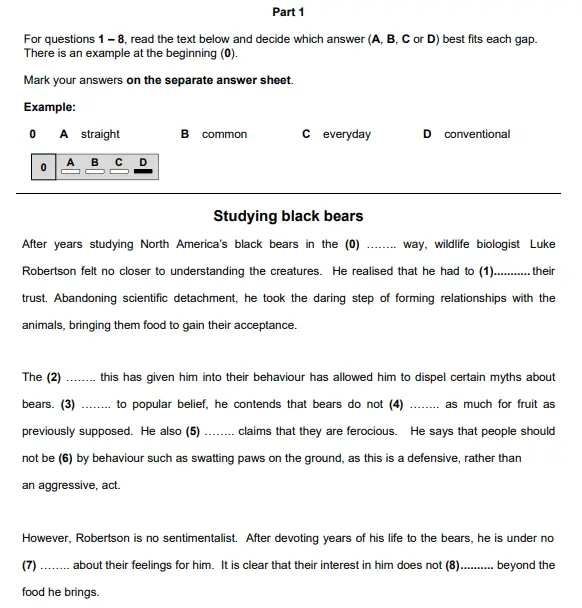
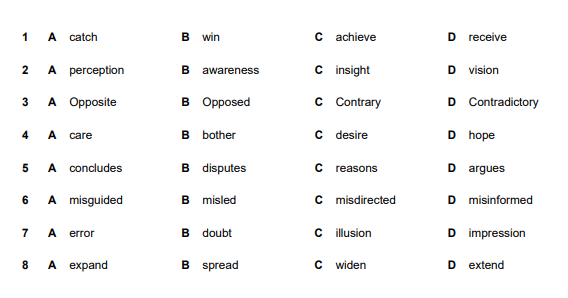
Part 2 — Open Cloze
Part 2 of the reading and use of English contains eight questions and still uses the Cloze Test Type of questions. It means that the paragraph presented in this part has missing words or texts which you need to fill in.
It uses the open cloze test format, which differs from part 1, a multiple-choice cloze. For part 2, you need to provide the missing words in the given paragraph without any choices, unlike in part 1, where you are given options.
In this test, you need to be more careful in answering since you only need to provide one word for each missing text. However, using contractions such as I’m, won’t, can’t, you’re, doesn’t, haven’t, and the likes, which are two words, will not be considered since the required answer is only one word.
In some instances, more than one word can fill in the missing gap in the paragraph.
And an example of it, “whereas” and “might”; however, it is not advisable to write down both words. To prepare for the open cloze test, you need to focus on linking phrases, prepositions, vocabulary, grammar, and awareness in detecting grammatical errors.

Part 3 — Word Formation
Part 3 of the reading and use of English is about word formation. The goal of this test is to assess your ability to change a word into another form. In addition, your knowledge about using prefixes and suffixes is put to the test. The word-formation test also assesses your spelling skills and reading comprehension.
In this test, a selection with missing words is presented to you. There are eight missing words that you need to fill in for part 3. Your task is to provide the missing word in the sentence or phrase. And also, a word stem is presented on the side to give you an idea of what the missing word is about.
Part 3 is different from part 2 because you are given a base word here, while in part 2, there are no choices or any other clue given. There is also one example shown for the word-formation part before you start answering the test properly.
The example provided will help you get the gist of what the test is about. To practice for part 3 of the reading and use of the English test, you need to study vocabulary, synonyms, and the use of affixation.
You also need to learn about internal changes in the phrase and the compounding composition of words works. You also need to understand sentence structure, the function of verbs, nouns, adjectives, and adverbs.
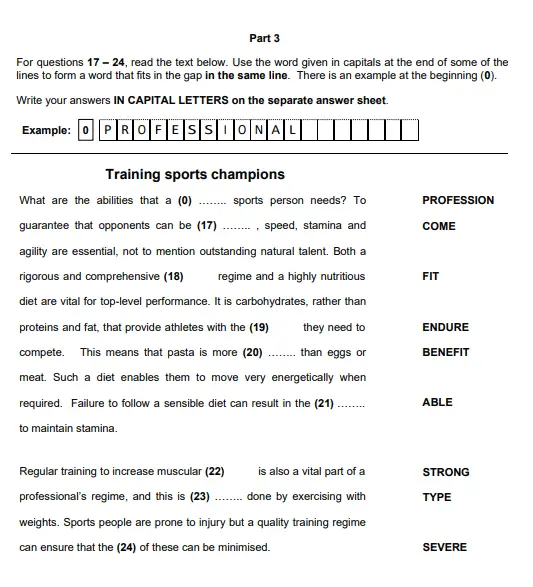
Part 4 — Key Word Transformation
Part 4 of the reading and use of English is about keyword transformation. In this test, you are given one keyword per number that you need to answer.
And there are also six numbers or questions in this part. The keyword is given together with a lead-in sentence. The objective here is to provide a phrase to complete the sentence using three to six words, including the given keyword. An example is also presented showing how to answer the test to understand what to do with the following questions.
Your goal here is to construct a sentence or provide a phrase with the same meaning or context as the lead-in sentence using the one keyword provided. Note that you are not required to change the tenses of the words or even change the word itself, but you need to use the word provided.
To prepare for part 4, you need to focus more on grammar, tenses of verbs, and collocation. It is also best to improve your vocabulary and knowledge of the different prepositions, noun forms, and the likes.
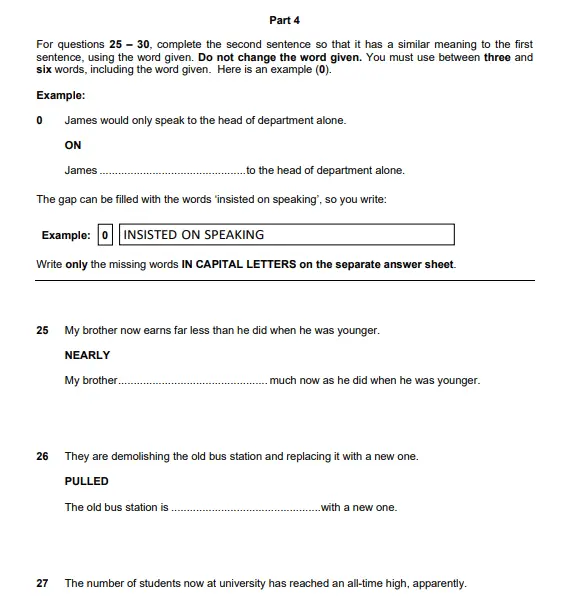
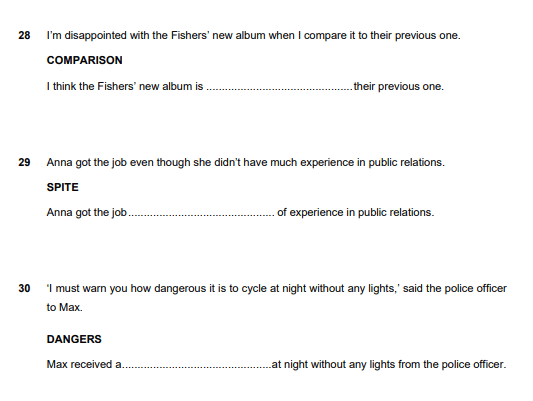
Part 5 — Text With Multiple-Choice Questions
As for part 5 of the reading and use of English paper of the CAE C1 Advanced test involves reading a long text or a selection, and then six comprehension questions follow it. The goal of this test is to assess your reading and comprehension skills.
The long text in this part may come from an expert from a novel, an informative essay, or may talk about any general knowledge topics. The follow-up questions are a multiple-choice type. All the questions presented here are connected to the given reading material.
And to prepare for this part, you need to focus on identifying details, main idea, tone of the passage, purpose, learn inference, and the organization of the given reading material.
It is also essential to read the assigned material and the follow-up questions carefully because they are sometimes tricky. Finally, remember that this test assesses whether or not you have understood the context given.
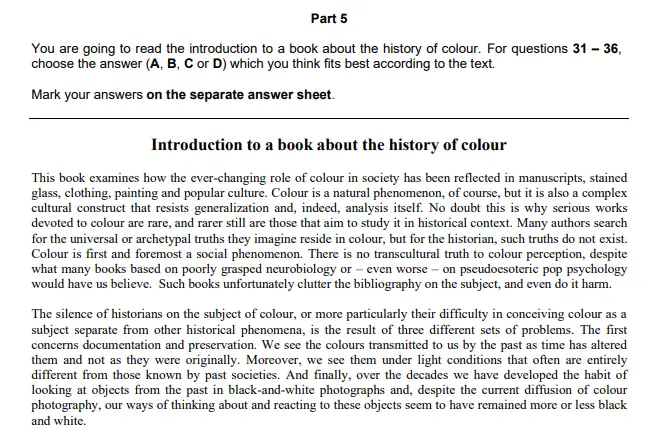


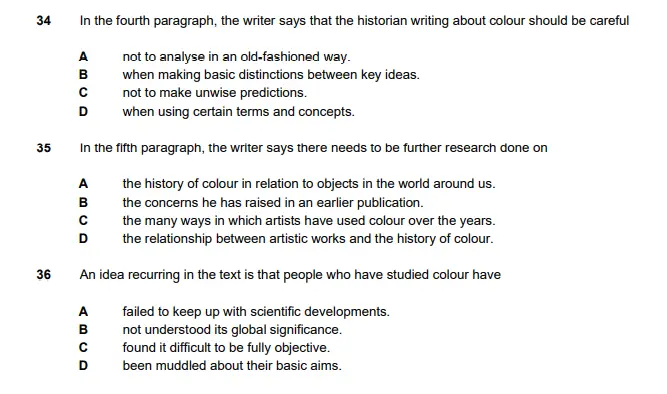
Part 6 — Cross Text Multiple Matching
There are four short texts with a different tone in writing presented in this part. Multiple matching-type questions also follow it. For this part, you need to read all the four short paragraphs shown to match the prompt elements in the texts.
This test aims to assess your ability to understand different opinions and contexts and compare them to each other. Therefore, you need to carefully read each text given and find out their differences and similarities.
This part contains four questions. And to practice this, you need to understand different viewpoints about a specific topic, know the different tones of the writer, validate opinions, and more.
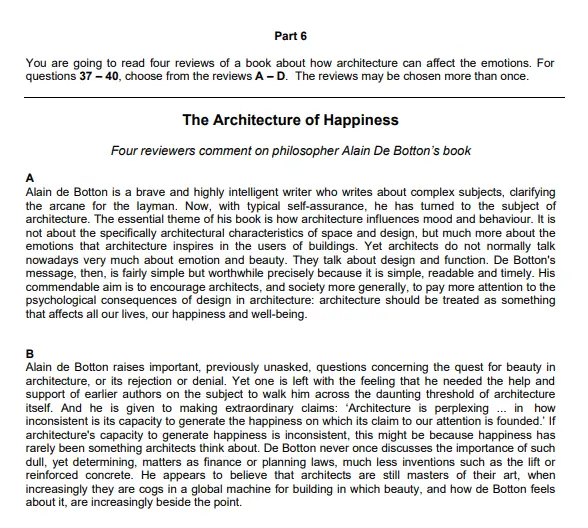

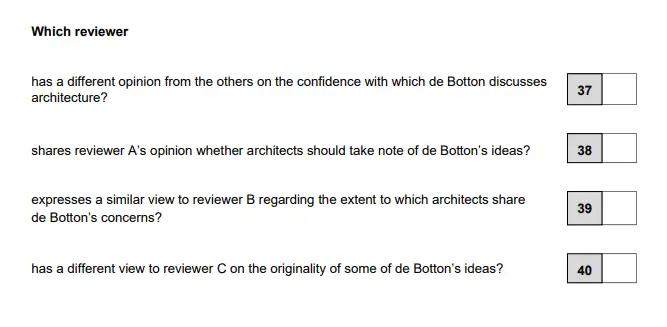
Part 7 — Text With Paragraphs Missing
There are six questions for this part. You are given here a selection that you need to read. Note that the selection has missing paragraphs that were intentionally deleted, and you need to select the best ones that suit the context from the given choices.
The goal here is to put the missing paragraphs in the correct order, and it also assesses your ability and understanding of sentence and paragraph structuring.
However, you also need to be careful in answering this part because the choices contain an extra paragraph that does not fit the given context.
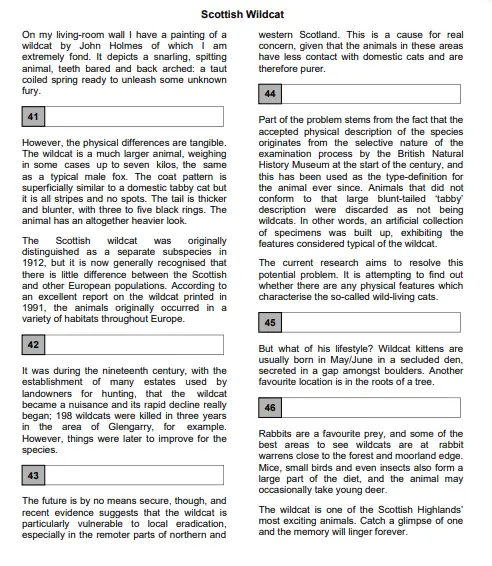
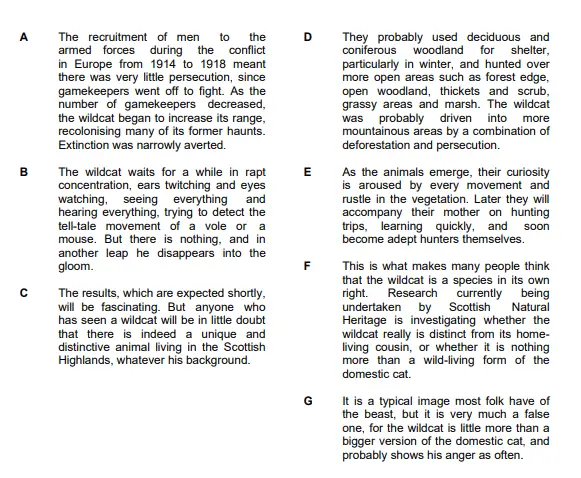
Tip: You are going to read an extract from a magazine article. Six paragraphs have been removed from the selection. Choose from paragraphs A – G the one which fits each gap (41 – 46). There is one extra paragraph that you do not need to use.
Part 8 — Multiple Matching
The last part of the reading and use of English paper is a multiple matching type of test. You are tasked to match the prompts presented to the correct part of the text. It simply means that you need to match the ten questions to the short paragraphs provided correctly.
There are ten questions for part 8, and you are given four to six short paragraphs to read. This test aims to assess your ability in reading, especially about identifying specific information, details, opinion, the tone of the writer, and the likes.
To practice for this test, you need to learn to identify keywords in a paragraph, synonyms, and comprehension.

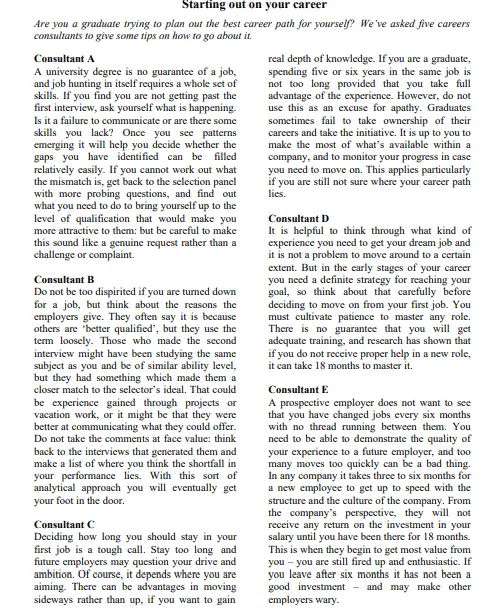
Tip: You will read a magazine article in which five career consultants advise about starting a career. For questions 47 – 56, choose from the consultants (A – E). The consultants may be selected more than once.
2. Writing
The writing paper of the CAE C1 Advanced Test contains two parts of writing tasks. And you are given approximately one hour and 30 minutes to complete both writing tasks.
This writing test aims to assess your writing skills in writing various papers, including essays, articles, proposals, letters, reports, reviews, and more.
The Writing Paper Section has two test parts:
- Part 1 — Write an Essay with A Discursive Focus
- Part 2 — Situationally Based Writing Task
Part 1 — Write an Essay with A Discursive Focus
In part 1 of the writing paper, you are tasked to write an essay about the information presented. You are expected to explain the two points of the context and provide information that will support your opinion.
The essay you are going to write should contain 220 to 260 words. And the goal of this part is to assess your skills in expressing opinions, evaluating information, and persuading the reader of your write-up.
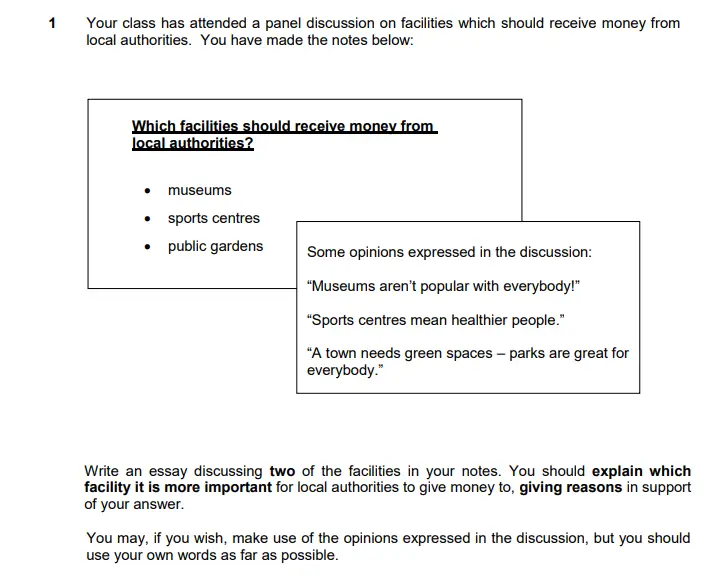
Part 2 — Situationally Based Writing Task
In this part of the writing paper, there are three situationally based questions presented. However, you only need to choose one among the three to write an essay about. And you need to compose an essay with 220 to 260 words for this part.
There are different text types in this part, which means that you may be required to write an email, proposal, report, or review. Again, it depends on what question you will choose to answer. Note that your grammar, sentence structure, paragraphing, and spelling are also assessed in this test.
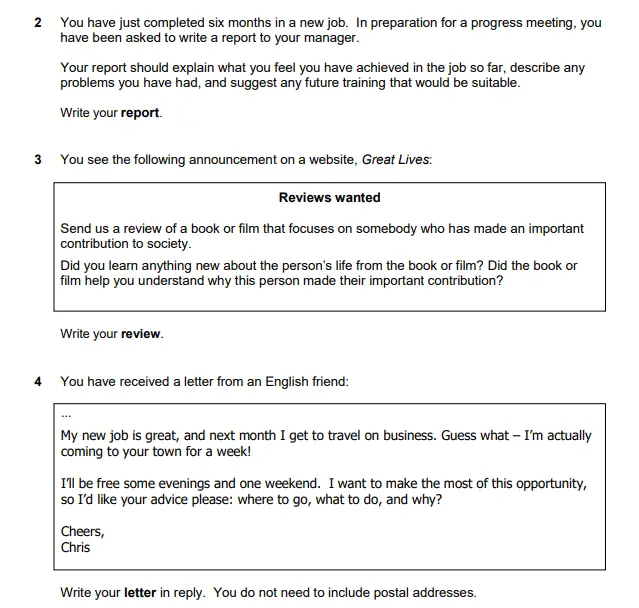
Tip: Write an answer to one of the questions 2 to 4 in this part. Write your answer in 220 to 260 words in an appropriate style on a separate answer sheet.
3. Speaking
The speaking paper for the CAE C1 Advanced Test contains four parts. You are given 15 minutes with your pair to complete the whole four parts of the speaking paper.
An interlocutor is present in this part of the CAE C1 Advanced Test that will guide the entire duration of the discussion or the whole period of the speaking paper. Note that you need to pair with another candidate for this paper. This test assesses your ability to communicate effectively in face-to-face situations.
There are four Test Parts of the Speaking Paper:
- Part 1 — Interview
- Part 2 — Long Turn
- Part 3 — Collaborative Task
- Part 4 – Discussion Task
Part 1 — Interview
Part 1 is called the interview part of the speaking paper. Together with the other candidate that is your pair, you will answer questions given by the interlocutor. The questions are usually about personal interests, career, studies, travels, and the likes.
The duration of part 1 is only two minutes, so you need to make sure that you have answered the questions to the best of your ability. The test assesses your skills and capabilities in answering questions, how well you can provide information about yourself, and how you speak about your opinions about specific topics.
Part 2 — Long Turn
In the second part of the speaking paper, the interlocutor will present three pictures wherein you need to choose two and discuss them. Then, you are given a minute to talk about the images you have chosen, and your pair, the other candidate, is also given 30 seconds to comment about your talk.
After you are finished, it is your pair’s chance to discuss, and the process is still the same, wherein you need to comment about your pair’s discussion for 30 seconds. Note that the sets of pictures presented to both of you are different.
This part of the speaking paper assesses your ability to speak, express your opinions, describe situations, point out comparisons and differences, and speculate.
Part 3 — Collaborative Task
In this part, you will have a collaborative talk with your pair. The interlocutor will give instructions about the task orally, and there is also a written prompt to guide both of you for the task. In this part, you are to speak together for two minutes about a topic.
The interlocutor will ask questions wherein you and your pair need to come up with a decision. Then, you are given one minute to discuss this as a team. Finally, part 3 assesses your ability in evaluating ideas, negotiating, justifying opinions and facts, and the likes. The whole duration of this part is around three minutes.
Part 4 — Discussion Task
The last part of the speaking paper is a discussion task. However, this part is a continuous discussion for part 3. And the duration of this test is approximately five minutes.
And also, in this part, the interlocutor will still ask you some questions, and you need to discuss them. Therefore, to prepare for this part of the speaking paper, you need to focus more on your speaking skills, how you deliver your speech, how you express your opinions, interact, and point out your agreement or disagreement for a particular topic.
4. Listening
The CAE C1 Advanced Test listening paper contains four parts. In every part of this paper, there are short extracts that you need to listen to and answer the following questions. And there are a total of 30 questions for this paper, and it makes up 20% of the whole CAE C1 Advanced Test.
You are given 40 minutes to finish the listening paper. It aims to assess your capabilities and skills in following and understanding a series of audio clips, including lectures, radio broadcasts, presentations, speeches, interviews, day-to-day conversations, and other conversational materials.
To prepare for the listening paper, it is best to listen to the radio, podcasts, recordings about interviews, anecdotes, talks, lectures, and other interacting discussions between speakers.
There are for test parts of the Listening Paper:
- Part 1 — Three Short Extracts From Conversations with Multiple-Choice Questions
- Part 2– Sentence Completion
- Part 3 — Conversation with Multiple-Choice Questions
- Part 4 — Multiple Matching
Part 1 — Three Short Extracts From Conversations with Multiple-Choice Questions
In this part, there are three different short extracts between speakers that are presented. And you are tasked to listen to the audio, which will be played twice. There are six multiple-choice questions after every extract.

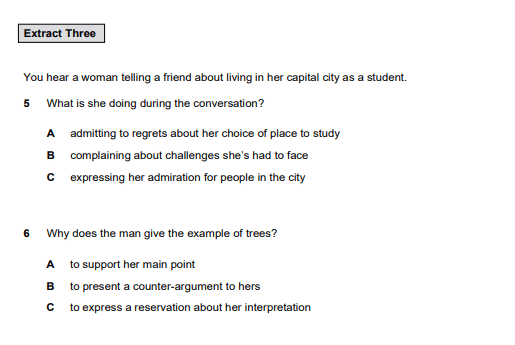
Part 2 — Sentence Completion
This part is about a sentence completion task. You will need to listen to a monologue that will usually last up to three minutes. And you are tasked to complete the sentences in the paragraph using the information you have heard from the audio clip.
There are eight questions in the sentence completion part. This test assesses your ability to listen and comprehend specific information, opinions, and other relevant details you have gathered from an audio clip.
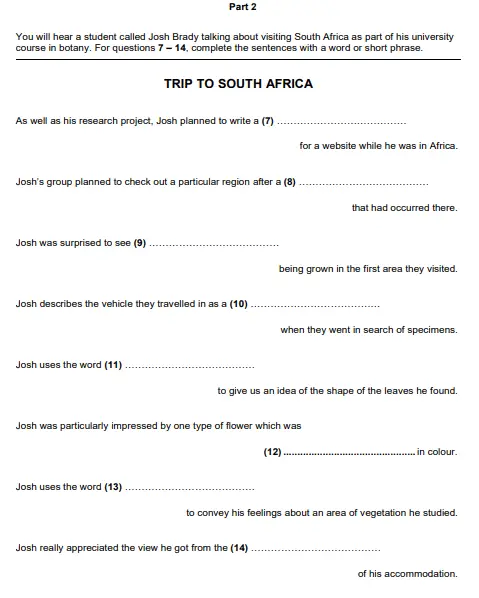
Part 3 — Conversation with Multiple-Choice Questions
In this part, you will hear a four-minute conversation between two or more people or speakers. And also, this test contains multiple-choice type questions, so you have a choice to choose from in answering the questions.
There are six questions for part 3 of the listening paper. The test aims to assess your skills in listening for agreement, essential details of the conversation, the gist of the context, opinions of the speakers, and more.

Tip: You will hear an interview in which two journalists called Jenny Langdon and Peter Sharples talk about their For questions 15 – 20, choose the answers (A, B, C, or D) which you think best fits according to what you have heard from the audio clip.
Part 4 — Multiple Matching
In the last part of the listening paper, five topic-based monologues last approximately 30 seconds are presented. There are two tasks that you need to comply with within part four. And it also makes use of the multiple-matching type of questions.
You need to match the correct speaker to the corresponding statements presented in the questions below for this test. You also need to identify if it is the accurate statement of the speaker during the monologues presented.

Tip: You will hear five short extracts in which people are talking about changing their jobs. Select the best answer according to the audio you have listened to.
How Does Scoring for the CAE C1 Exam Work?
CAE C1 points system follows a 0 to 100 grading where 0 is the lowest and 100 is the highest.
This points system provides individual scores to individual papers of the CAE C1 Advanced Test, such as listening, speaking, reading, and English and writing papers.
The grading of 0 to 100 has a corresponding Cambridge English Scale with A to grade E grading.
The Cambridge English Scale is a standardized scale used in all of the Cambridge English exams. Note that it is not the overall score for the whole exam.
Here is the pointing system with its corresponding Cambridge English Scale and CEFR Levels.
| Point Grading (Total marks of 100) | Cambridge English Scale | CEFR Level |
|---|---|---|
| 100 – 80 | Grade A | Certificate Level C2 |
| 79 – 75 | Grade B | Certificate Level C1 |
| 74 – 60 | Grade C | Certificate Level C1 |
| 59 – 55 | Grade D | No Certificate |
| 54 – 0 | Grade E | No Certificate |
All the individual scores in the individual CAE C1 papers, such as reading and use of English, speaking, writing, and listening, are combined to achieve the exam’s general score. The general score of the CAE C1 ranges from 210 to 142 points, and it also has a corresponding Cambridge Scale and the CEFR Levels.
Here is the general score of the CAE C1 with its Cambridge English Scale and CERF Levels.
| Cambridge English Scale Score | Cambridge English Scale | CEFR Level |
|---|---|---|
| 200 – 210 | Grade A | Certificate Level C2 |
| 193 – 199 | Grade B | Certificate Level C1 |
| 180 – 192 | Grade C | Certificate Level C1 |
| 160 – 179 | Level B2 | No Certificate |
What are CEFR Standardized Levels?
The CEFR (Common European Framework of Reference for Languages) is a relevant reference for language proficiency. It has six levels that consist of A1 to C2. The highest CAE scale is Grade A which is equivalent to CEFR Level C2.
Here are the CEFR Levels with their corresponding descriptors.
| CEFR Levels | Language Proficiency Level | Level Descriptions |
|---|---|---|
| C2 | Mastery Level |
|
| C1 | Advanced Level |
|
| B2 | Upper-Intermediate Level |
|
| B1 | Intermediate Level |
|
| A2 | Elementary Level |
|
| A1 | Beginner Level |
|
CAE C1 Advanced Exam Dates and Locations
The CAE C1 exam is administered 11 times annually, and it is scheduled between February and December.
You can either take the paper-based test or the computer based-test. The exam schedules will depend on what format of the CAE C1 Test you will take.
To register for the CAE C1 exam, you need to visit your area’s nearest official testing centers. You may also visit their official website to find the authorized exam centers in your location and their contact details.
The Cambridge Test has more than 2,800 testing centers worldwide. For sure, you have one in your area. To pay for the CAE C1 exam, you can do so by using your debit card, credit card, or prepaid. If you have completed all the registration processes, a test schedule will be given to you.
When are the CAE C1 Certificates Available After the Exam?
The CAE C1 certificates are available within four to six weeks after you have taken the CAE C1 paper-based exam. The certificates will be available within two to three weeks for those who have taken the CAE C1 computer-based test.
All the CAE C1 certificates will be available in the testing centers where you have taken the test, and the certificate will show the level you have achieved depending on your test results. And it is best to contact their official testing centers to know more about when and how to get your CAE C1 certificates.
How to Prepare for the CAE C1 Test?
We all now know that the CAE C1 Test is one of the most in-demand English language advanced tests required by universities, colleges, and organizations worldwide. And it is also one of the in-depth assessment tools used to measure your English proficiency skills.
Given these facts about the CAE C1 Test, crucial preparation is needed before you jump into taking the test. However, you already have the English language skills and abilities to take this test, but it is not enough to rely on them solely.
If you want to ace the CAE C1 Test, we have come up with effective but simple ways to help you prepare for it.
1. Be Familiar with the CAE C1 Test Structure
You might be wondering why we started with familiarizing yourself with the CAE C1 test structure. Among the essential things you need to prepare is knowing the exam structure of the test you will take.
Why? Okay, to start, it will help you gear up and be prepared for what is coming. You will learn the different types of questions in each paper, and you will also know how the test looks and its duration. Remember that the CAE C1 test has a time limit for every paper.
We already have discussed the CAE C1 Test formats and structure in the early parts of this article. Study the test formats in every paper of the CAE C1, and you can create a guide for your study plan.
If you find something hard in the test structure or are not familiar with it, you still have the time to gather enough information about it. For example, you may look for similar practice tests for that one that you find difficult.
Keep in mind that familiarity with the exam structure is one step to help you ace the test. You will not be taken aback when you take the test because you already have an overview of what it looks like and all. On another note, familiarizing the exam structure can also help you be confident in answering the test, and it will be more manageable on your exam schedule.
2. Make A Study Guide
After familiarizing yourself with the CAE C1 exam structure, you can now easily make a study guide. In connection, you may anchor your study guide with the exam parts that you find difficult.
For example, you can create a daily study guide per paper. Like on Mondays, you will review for speaking, and on Tuesdays, you will practice for the reading and use of English. Remember to organize your schedule according to your level of difficulty. It simply means you need to create a study guide that is effective for you.
You can also make a study plan according to your study habits and learning styles. For example, what time of the day are you most likely to have more focus on studying? Is it early morning or late at night? Are you a visual or an auditory learner? What do you prefer?
Also, remember that what works for you might not work for other people. So it is best to stick with what works best for you. Finally, keep in mind that you also need to focus on your strengths and weaknesses in English language skills. Your study guide will help you focus on your strength and weaknesses in the language.
3. Take More Practice Tests
One of the most important and effective ways to ace the CAE C1 test is to take a lot of practice tests. Taking a practice test as much as you can help you upgrade your skills and speed in taking the exams.
The practice tests will help you familiarize yourself with the test structures and build confidence in answering the CAE C1 test. It will also help you evaluate progress, how far you have come, or whether you need to focus on more areas.
Do not be stressed out with your scores on these practice tests. Note that it is only a practice test, and you can do more next time. There is nothing wrong if you fail a part of it. Just keep going.
Remember that practice makes perfect and if you want to ace the CAE C1 test, take a lot of practice tests. There are also many available free practices tests offered online, and you can easily browse for them on the internet. And there are also different online preparation courses provided, and you can also enroll in these courses to help you with your preparation.
4. Take A Break
Taking a break is also equally important with your preparation. Do not be too hard with yourself, and there will be times that you might feel that you are not meeting your expectations. But trust the process. It takes one step at a time to achieve perfection and excellence.
Do not linger on your failures, but rather keep going. Remember, too much pressure and overworking yourself is not suitable for your health in all aspects. You do not want to lose focus and concentration. Take a break if you must, and believe in yourself that you can ace this CAE C1 Test. Boost your confidence, and you will indeed have a long way to go.
Additional FAQs on the CAE C1 Advanced English Exam
What Is the Highest English Language Certification?
In addition, it is the highest level of the CEFR (Common European Framework of Reference for Languages), one of the most widely used and highly recognized benchmarks for language proficiency levels.
Is CAE for Life?
However, some universities and other institutions require a recent result for CAE C1 for admission purposes. Thus, it is best to contact your desired educational institution or company for their requirements.
Is CAE Difficult?
However, you have all the skills needed to pass the CAE C1 test, and you just need to practice and prepare for it. And for sure, with your dedication and perseverance, you can easily ace this language exam.
